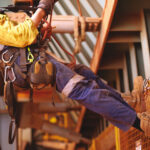Search results for: confined spaces
OSHA’s General Industry Regulation: 29 CFR 1910.146, Permit-Required Confined Spaces
Sponsored by: Industrial Scientific Important to Know: OSHA’s Permit-Required Confined Spaces manual overviews this standard, stating: “Many workplaces contain spaces that are considered to be ‘confined,’ because their configurations hinder the activities of employees who must enter into, work in or exit from them. Due to the work environment, employees who perform tasks in confined…
Read MoreGas Detection and Monitoring in Confined Spaces
By: Barbara T. Nessinger, Chief Editor Employees of industrial firms often find themselves, for a multitude of reasons, working in a confined space. Worker health and safety is critically important in these situations. To that end, the U.S. Occupational Health and Safety Administration (OSHA) has many regulations which focus on providing a safe working environment…
Read MoreIncrease Safety, Inspect Confined Spaces Without Entry
Zistos’ Industrial Zoom Inspection System allows the operator to remotely inspect areas that may be inaccessible or dangerous to enter such as vats, tanks, hoppers and other confined spaces, while performing a visual assessment for corrosion, residual heel, contaminants, and delamination — without entry. The system increases the safety and efficiency of necessary inspections for…
Read MoreErgodyne’s Aerial Bucket Series Takes Dangerously Confined Elevated Worksites Into a New Class of Safety, Organization and Efficiency
Ergodyne announced the launch of an all new Aerial Bucket Series designed specifically for safer, easier work in bucket trucks and elevated work platforms. The collection features a tool board and tool bag—each engineered with extensive worker feedback and boasting a multitude of pockets and ANSI-approved tethering points for securely storing and safely accessing tools in confined work…
Read MoreOSHA’s “Limited or Restricted Entry & Exit” Confined Space Definition
Michelle Graveen, ASP, SMS, editor, J. J. Keller & Associates As a business or group leader, it’s important to understand what is considered limited or restricted means of entry and exit, and how it affects your employees’ safety. The Occupational Safety and Health Administration’s General Industry standard at 29 CFR 1910.146 defines a confined space…
Read MoreU.S. Department of Labor Stresses Workplace Safety During 2024 Stand Up 4 Grain Safety Week
National initiative seeks to reduce injuries, fatalities in high-hazard industry Home of the iconic Corn Palace — a symbol of the region’s healthy agricultural climate since 1892 — Mitchell, South Dakota will be the host location on March 25 for the national kick-off of the 2024 Stand Up 4 Grain Safety Week. This year’s event, from March 25-29,…
Read MoreANSI Z245.5-2013 – Baling Equipment – Safety Requirements for Installation, Maintenance and Operation
“American Baler is dedicated to meeting or exceeding safety demands, including the ANSI standard for balers. Our Head of Engineering sits on the ANSI committee. Our balers were the first to achieve Category 3 safety standards on all models. Our customers demand the safest balers, and we lead the way!” American Baler, 800-843-7512, www.americanbaler.com ANSI…
Read MoreANSI/ASSP Z359.11-2021 – Safety Requirements for Full Body Harnesses
“As a global leader in fall protection, we’ve learned that poorly-designed fall protection PPE makes it difficult to keep you and your work safe, compliant and efficient. To address this, we’ve developed the new Honeywell Miller® H700 Full Body Harness, utilizing ergonomic scientific findings to improve safety and comfort.” — Marc Dudelzak, Honeywell Miller Offering…
Read MoreRecognizing and Protecting Against the Dangers of Footwear Degradation
Under-performing footwear can lead to serious workplace safety risks. By: Robert McCarthy, Contributor We have all encountered a situation where the shoes we wear daily for work start to wear out. Whether it’s losing outsole traction or the leather upper starting to crack, wearing shoes that have begun to break down can be dangerous. Footwear…
Read MoreASSP Online Safety Series Spotlights General Hazards
The American Society of Safety Professionals (ASSP) has planned a second installment of its new workplace safety education series called “Stand Up for Standards.” A live two-hour webinar on general industry hazards will take place from 1 p.m. to 3 p.m. CT September 28, helping occupational safety and health professionals minimize on-the-job risks to prevent…
Read More





